How to Fly a Drone
A Beginner's Guide to Multirotor Systems & Flight Proficiency
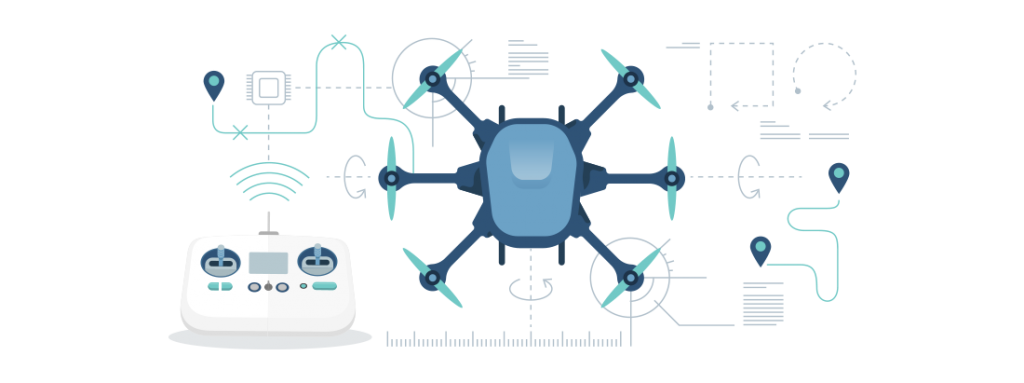
In this guide, you’ll learn how to fly a drone.
Everyone goes through different struggles when piloting a drone for the first time. Multirotor flying definitely has a learning curve.
So if you’re having trouble flying your drone, you’re just getting started, or you’re looking to hone your skills — don’t worry.
You’re in the right place.
For a quick look at our top recommended exercises, check out our YouTube video here:
No matter your drone model, the rest of this guide will help you prepare for your first flight, stay safe, get airborne, and learn some basic and advanced drone flying techniques.
Our goal is to give you a guide that will take out all of the guesswork – from going through a pre-flight checklist, learning the controls, controlling your drone’s flight pattern, and even some advanced techniques.
Have fun!
Note: If you haven’t bought a drone yet, check out our review of the best remote control drones. And if you’re looking to get your FAA license, here is a discount code for Drone Pilot Ground School, our industry-leading Part 107 test prep and training course.
What You Will Learn In This Guide
We know that not all aspiring commercial pilots or hobbyists are on the same level.
To help you work on specific skills, we’ve put together an interactive table of contents. Click each link to be transported to different sections.
(Or, you can scroll down and start from the beginning.)
- Getting Started // Drone controls
- The pre-flight checklist
- How to get your drone off the ground
- How to hover in mid-air and land your drone
- Flying your drone left/right and forwards/backwards
- How to pilot your drone in a square pattern
- How to fly a drone in a circle
- How to rotate your drone
- Flying a drone continuously
- Different milestones to pass
- Advanced drone flying techniques
- Next steps
Interested in becoming a commercial drone pilot? Learn more about the FAA’s Part 107 certification process here.
Getting Started // Drone Controls
When learning how to fly a drone, the controls will become second nature once you know how they operate and interact together to form a complete flying experience.
When you first start out, push the sticks very gently so the drone performs slight movements. As you get more comfortable, you can make sharper movements.
(Note: For simplicity’s sake, this article assumes that the left stick controls yaw and throttle, and the right stick controls roll and pitch. Some transmitters allow the pilot to switch these controls based on what’s most comfortable.)
There are four main drone controls:
- Roll: Done by pushing the right stick to the left or right. Literally rolls the drone, which maneuvers the drone left or right.
- Pitch: Done by pushing the right stick forwards or backward. Tilts the drone, which maneuvers the drone forwards or backward.
- Yaw: Done by pushing the left stick to the left or to the right. Rotates the drone left or right. Points the front of the copter in different directions and helps with changing directions while flying.
- Throttle: To increase, push the left stick forwards. To decrease, pull the left stick backward. This adjusts the altitude, or height, of the drone.
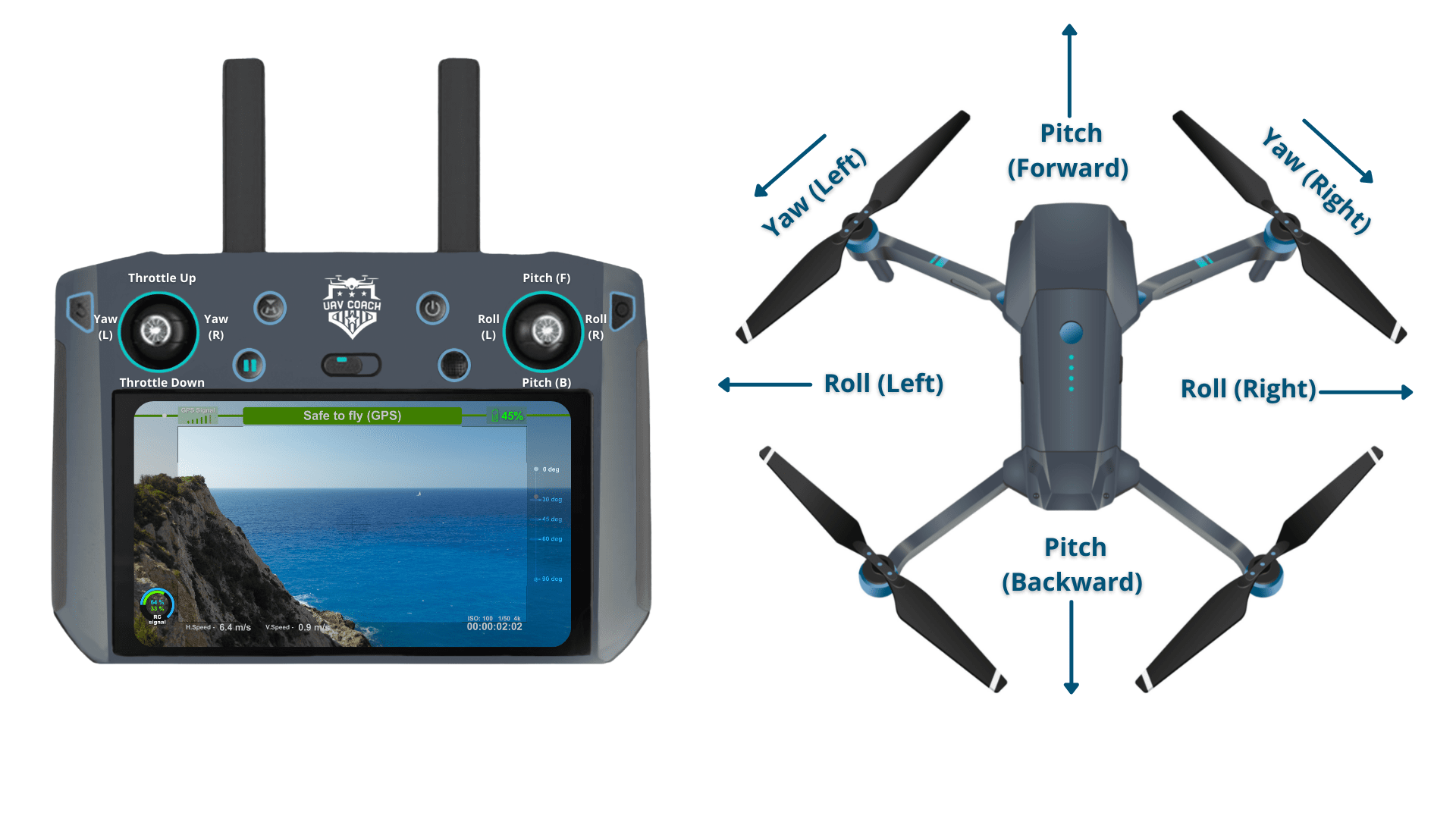
Let’s go through each of them.
Roll (Right Stick)
Roll moves your drone left or right. It’s done by pushing the right stick on your controller to the left or to the right.
It’s called “roll” because it literally rolls the drone.
For example, as you push the right stick to the left, the drone will roll to the right.
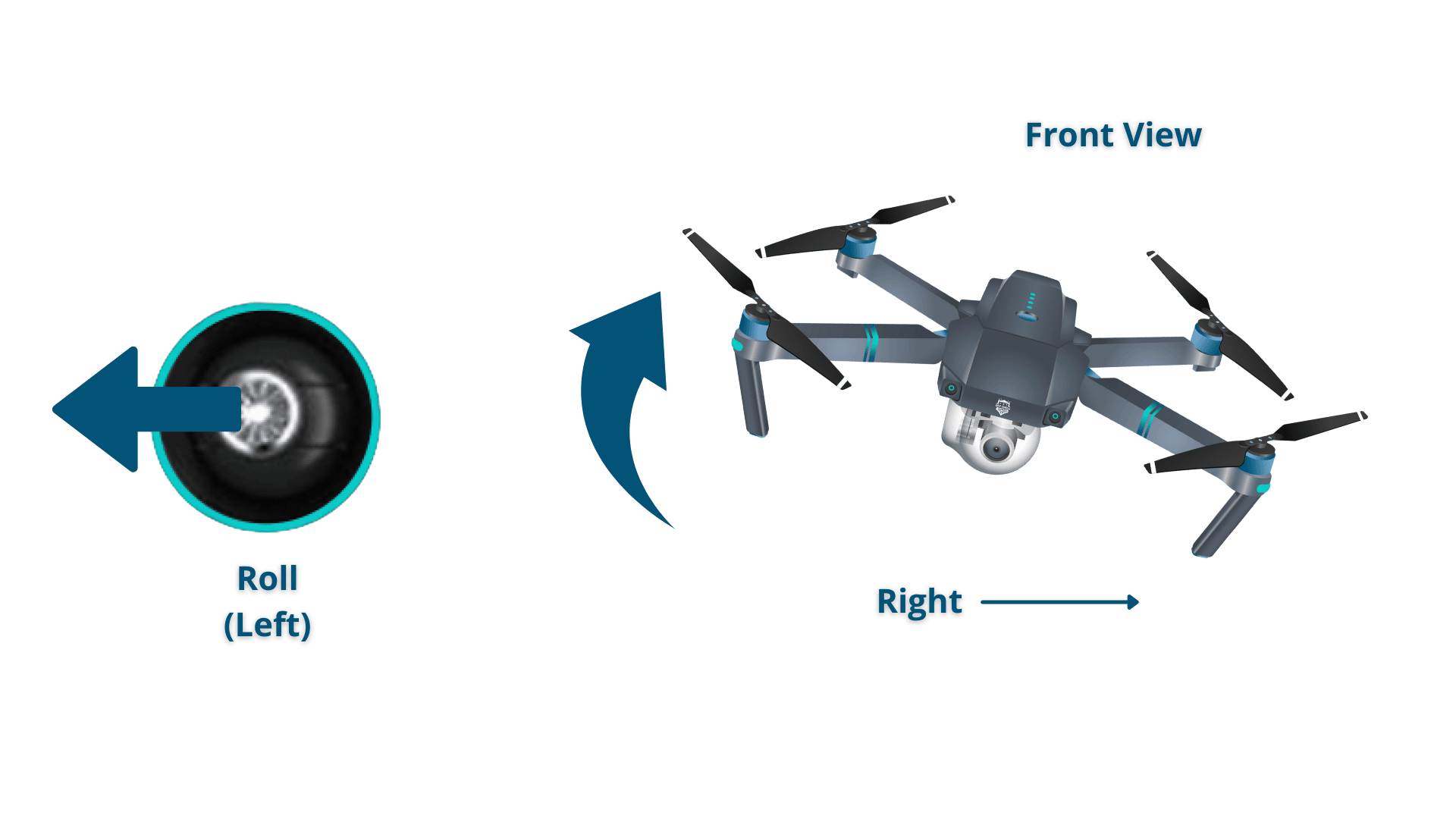
When you push the right stick to the right, the drone will roll to the left.
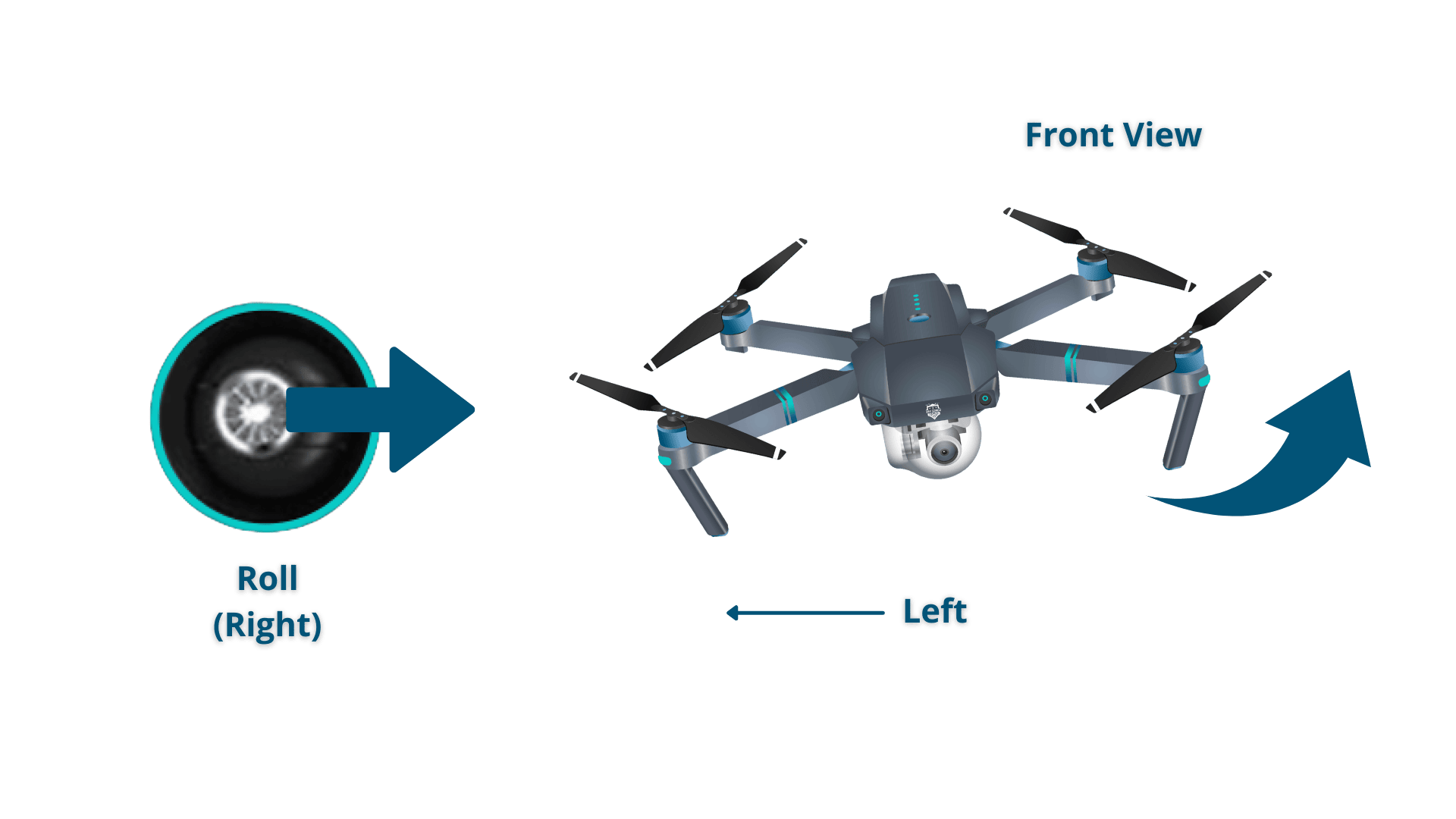
Pitch (Right Stick)
Pitch is done by pushing the right stick on your controller forwards or backward. This will tilt the drone, resulting in forwards or backward movement.

When the right stick is pushed forward, the back of the drone will pitch up causing the air to push the drone forward.
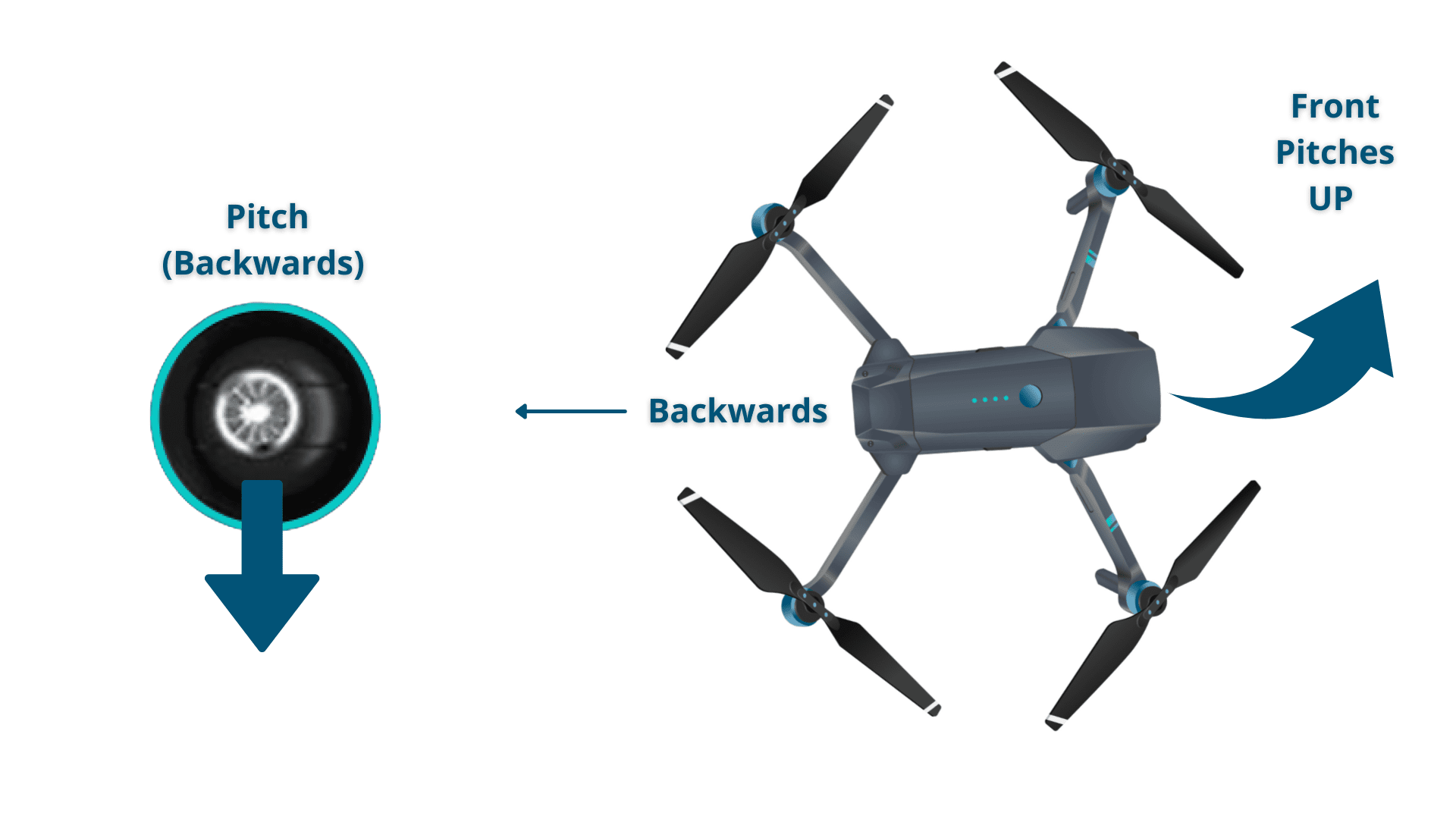
If the right stick is pulled backward, the front of the drone will pitch up causing the air to push the drone backward.
Yaw (Left Stick)
Yaw was a little bit confusing for me in the beginning. Essentially, it rotates the drone clockwise or counterclockwise.
This is done by pushing the left stick to the left or to the right.
Check out the video below for an example.
(Watch from 1:59 to 2:44 and pay attention to how he adjusts the sticks.)
Yaw is typically used at the same time as throttle during continuous flight. This allows the pilot to make circles and patterns. It also allows videographers and photographers to follow objects that might be changing directions.
Throttle (Left Stick)
Throttle gives the propellers on your drone enough power to get airborne. When flying, you will have the throttle engaged constantly.
To engage the throttle, push the left stick forward. To disengage, pull it backwards.
Make sure not to disengage completely until you’re a couple of inches away from the ground. Otherwise, you might damage the drone, and your training will be cut short.
Important Note:
When the drone is facing ‘away from you’, camera pointed away from you, the controls are intuitive and…
- Pushing the right stick to the ‘right’ rolls the drone right and pushing the stick to the ‘left’ rolls the drone to the left.
- Pushing the right stick ‘forward’ moves the drone away from you and pulling the stick ‘backward’ causes the drone to move toward you.
But when the drone’s camera is facing you, the controls are inverted and the drone will move in the opposite direction based on the stick input.
- If you move the right stick to the right the drone will move left and if you push the stick to the left the drone will move right.
So pay close attention to the way the drone is oriented toward you when you start providing stick input.
Pre-Flight Checklist
Going through a pre-flight checklist will keep you and your drone safe.
Here’s a checklist you can use before each flight:
WEATHER & SITE SAFETY CHECK
- Chance of precipitation less than 10%
- Wind speed under 15 knots (less than 20 mph)
- Cloud base at least 500 feet
- Visibility at least 3 statute miles (SM)
- If flying at dawn / dusk, double-check civil twilight hours
- Establish take-off, landing, and emergency hover zones
- Potential for electromagnetic interference?
- Look for towers, wires, buildings, trees, or other obstructions
- Look for pedestrians and/or animals and set up safety perimeter if needed
- Discuss flight mission with other crew members if present
VISUAL AIRCRAFT / SYSTEM INSPECTION
- Registration number is displayed properly and is legible
- Look for abnormalities—aircraft frame, propellers, motors, undercarriage
- Look for abnormalities—gimbal, camera, transmitter, payloads, etc.
- Gimbal clamp and lens caps are removed
- Clean lens with microfiber cloth
- Attach propellers, battery/fuel source, and insert SD card / lens filters
POWERING UP
- Turn on the remote control and open up DJI Go 4 app
- Turn on aircraft
- Verify established connection between transmitter and aircraft
- Position antennas on transmitter toward the sky
- Verify display panel / FPV screen is functioning properly
- Calibrate Inertial Measurement Unit (IMU) as needed
- Calibrate compass before every flight
- Verify battery / fuel levels on both transmitter and aircraft
- Verify that the UAS has acquired GPS location from at least six satellites
TAKING OFF
- Take-off to eye-level altitude for about 10-15 seconds
- Look for any imbalances or irregularities
- Listen for abnormal sounds
- Pitch, roll, and yaw to test control response and sensitivity
- Check for electromagnetic interference or other software warnings
- Do one final check to secure safety of flight operations area
- Proceed with flight mission
Getting Your Drone Off the Ground
Before we get started, let’s cover a few important safety protocols and recommendations. it is important to note that drones are not toys and can be dangerous. Let’s lay out some initial safety precautions to ensure a safe flight:
- If you’re about to crash into something, turn the throttle down to zero, so you don’t potentially destroy your drone, injure somebody, or injure yourself.
- Take out the battery of the drone before doing any work on it. If it turns on accidentally and the propellers start spinning, you might have a tough time doing future flights with missing fingers.
- Keep your fingers away from the propellers when they’re moving.
- If you’re a beginner learning to fly indoors, tie the drone down or surround it with a cage.
Choosing a safe and legal flight location is also crucial for a safe operation. Here are some tips on finding the perfect spot:
- We suggest starting out in a large, open space, such as a park or a field. Many people prefer to learn on grassy ground, so if the drone needs to make a crash landing, it will at least have some sort of cushion.
- Stay away from people or animals.
- Avoid windy conditions as a beginner and be aware of your drone’s performance limitations (refer to user manual).
- Lastly, choose a legal, safe, and visually interesting location to fly your drone. After a round of comprehensive research, our team compiled a list of where to fly a drone in various cities across the country.
Alright! Now that you understand the controls and you’ve taken all of the right safety precautions, you’re ready to fly.
- To get your drone in the air, the only control you need is the throttle.
- Push the throttle (left stick) up very slowly, just to get the propellers going. Then stop.
- Repeat this multiple times and until you’re comfortable with the throttle’s sensitivity.
- Slowly push the throttle further than before, until the copter lifts off the ground. Then pull the throttle back down to zero and let the drone land.
- If you want to get good visualization, check out this great video from My First Drone:
(Watch from 1:15 to 1:40)
Congrats! You know how to get your drone airborne.
Now, let’s learn how to hover in mid-air.
[Related read: The Top FPV Drones: A Complete Guide]
Hovering in Midair and Landing Your Drone
- To hover, you will use the throttle to get airborne. You will then use small adjustments of the right stick to keep the drone hovering in place.
- You may also need to adjust the left stick (yaw) slightly, to keep it from turning.
- Use the throttle to get the drone about a foot to a foot-and-a-half off the ground.
- Make tiny adjustments with the right stick (and the left, if necessary) to keep the drone hovering in position.
- When you’re ready to land, cut back the throttle slowly.
- When the drone is an inch or two off the ground, go ahead and cut the throttle completely and let the UAV drop to the ground.
- Repeat this until you get comfortable hovering off the ground and landing gently.
Flying Your Drone Left/Right and Forward/Backward
To fly a drone left, right, forwards, and backwards, you will need to hold the throttle at a steady rate to keep it airborne. You will then use the right stick to maneuver the drone in the direction you want it to go.
- First, bring your drone to a hover.
- Push the right stick forward to fly it a couple of feet forward.
- Pull the right stick back to bring it back to its original position.
- Now, move it further backwards a couple of feet, and return it to its original position.
- Push the right stick to the left to move your copter a couple of feet to the left.
- Move it back to its original position, then fly it a couple of feet to the right.
- If it starts to rotate (yaw), adjust the left stick to the left or right to keep the drone facing the same direction.
- (Pro tip: When you move in either direction, you will probably notice the drone dropping in altitude. To keep the drone at the same altitude, push the throttle and give it more power whenever you turn or move.)
Flying a Square Pattern
You’ve gotten off the ground, and you know how to fly a drone in the four basic directions.
Now, it’s time to combine these skills and start flying in patterns. This will help you get a feel for simultaneously engaging the controls.
- To fly in a square pattern, keep the drone facing away from you the entire time.
- Push the right stick forward (pitch) and fly forward a couple of feet. Then, return the right stick to the middle and hover in place.
- Then push the right stick to the right (roll) and fly to the right a couple of feet. Then, hover in place for a few seconds.
Related: Want to take your knowledge to the next level? Check out our premium online UAV training course for new pilots.
- Pull the right stick backwards and fly backwards a couple of feet. Then, hover in place for a few seconds, and push the right stick to the left and return the drone to its original position.
Need extra help? Watch the video below!
You’ve just flown in a square! Keep doing this until you get comfortable with it, and then move on to our next pattern – flying in a circle.
Flying a Circle Pattern
This is where you will hone your simultaneous control skills.
To fly a drone in a circle, you will use pitch, roll, and throttle at the same time.
- As usual, use the throttle to get airborne. Then, decide whether you want to fly clockwise or counterclockwise.
- For this example, we’ll assume you’re flying clockwise (to the right).
- Keep the drone facing away from you, and push the right stick diagonally up and to the right. This will engage both pitch and roll at the same time, and start flying the drone in a circle to the right.
- After a couple of feet, start rotating the right stick more to the right, so you engage more roll. This will start maneuvering your drone to the right.
- After a few more feet, start rotating the right stick diagonally to the bottom right, and continue to circle the right stick around until the drone returns to its original position.
- Try changing directions, and slowly rotating the right stick to fly in a circle. If you notice the drone starting to rotate and face different directions, adjust the drone’s yaw by pushing the left stick to the left or right.
Using Yaw Control to Rotate Your Drone
- To rotate your drone, use the throttle to get airborne.
- Once at a comfortable hover, push the left stick in either direction. This will rotate the drone in place.
- Rotate it 360 degrees. Then push the left stick in the opposite direction and rotate it 360 degrees the other way.
- Keep doing this until you’re comfortable with it.
Flying Continuously
Flying a drone continuously requires you to rotate and change directions simultaneously.
This will take some getting used to, because the drone will be facing different angles in relation to how you’re facing, so you will need to pay close attention to how each movement of the sticks will affect the drone’s flight.
- First, take off and hover.
- Rotate (yaw) your drone to a slight angle.
- Use the right stick to fly it left/right and forwards/backwards. Get comfortable flying the drone while it faces a different direction.
- Rotate it to another angle, and use the right stick to maneuver it again.
- Keep doing this until you’re comfortable flying at different angles.
- To fly continuously, slowly push the right stick forward.
- As you’re pushing the right stick forward, push the right stick slightly to the left or to the right at the same time.
- Fly in different directions by pushing the right stick forward (pitch) and adjusting it left and right, and using the left stick (yaw) to change the direction the drone is facing.
- Then, try adjusting the drone’s height by moving the left stick forward and backward (throttle).
Congrats! Now you know how to fly a drone with continuous movement.
Keep practicing until you can direct your drone at will. Then, move on to the next section, where we’ll discuss different milestones for you to shoot for.
Different Milestones to Hit
Use these milestones to keep you organized during the learning process.
They will help you gauge where you’re at and what you should be going for next.
- Learn how the four main drone controls – roll, pitch, yaw, and throttle – affect a drone’s movement.
- Understand the parts of your drone and what each of them does.
- Prepare a pre-flight checklist and go through it before each take-off (See Chapter 3).
- Understand the safety precautions.
- Use the throttle to get airborne, and make any necessary settings adjustments.
- Get comfortable hovering in mid-air and gently landing your drone.
- Take off to an altitude of 3 feet and land in the same position.
- Take off to an altitude of 3 feet and spin the UAV around 180 degrees.
- Get comfortable flying your drone left/right and forwards/backwards.
- Learn how to fly a drone in a square pattern.
- Learn how to fly a drone in a circle.
- Learn how to rotate (yaw) a drone.
- Learn how to fly a drone continuously.
- Do all of the above, but at an altitude of 25 feet.
- Pick two targets on the ground, and repeatedly land, fly, and land on each one.
Check out this video for an example of #7:
(Watch from 2:45 to 3:26)
Advanced Drone Flying Techniques
Here are some advanced flying techniques for you to master:
- Fly in a “figure 8” pattern. This will require you to fly the drone with the front-facing forwards the entire time.
- Bank turns (A consistent circular turn in either the clockwise or counterclockwise direction.) Keep a little forward pitch for forward movement. Apply throttle, and roll the drone in the direction of the turn (left or right).
If you’re still struggling to get the hang of it, Korey Smith from My First Drone put together a useful bank turns video.
Next Steps
Nice work, you’ve finished our ‘How to Fly a Drone training guide! We hope it gets you on your way to flying a drone like a pro.
So, where should you go from here?
You can practice flying your drone with one of our own UAV Coach instructors; they’ll meet up in person to teach you how to manage your sUAS flight operations and provide hands-on, drone flight training.

If you haven’t bought a drone yet, our drone buying guide will set you off in the right direction. You might also want to try out a drone flight simulator.
If you live in the U.S. and want to make money as a professional drone pilot, check out our drone certification guide here to learn more about getting certified. We also have a Drone Pilot Ground School training course to help you prepare for your written exam.
Also, feel free to subscribe to our YouTube channel to stay up-to-date with the latest UAV news, training, and information. Additionally, we’d love to see your drone footage, tag us on Instagram for a chance to be featured on our page!
Blue skies and safe flying out there!


